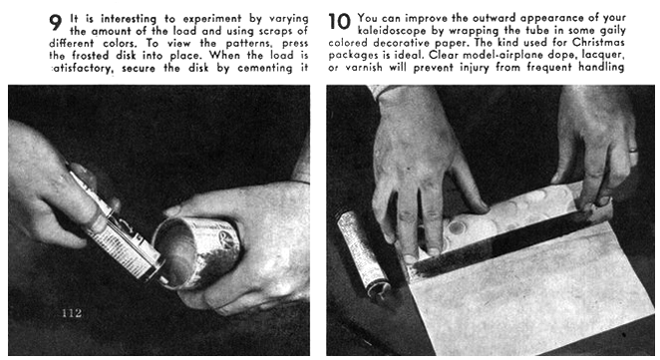 |
| Little girl playing with a home-made kaleidoscope. |
By HARRY WALTON
Photographs by WILLIAM MORRIS and ROBERT SMITH
Visitors to London about 1816 were amazed to see people in the streets gazing skyward through pasteboard tubes. But these watchers were peering at no eclipse or comet. They were fascinated by a scientific novelty that had taken London by storm the kaleidoscope, invented by Sir David Brewster. First regarded only as a toy, it was soon adopted by artists as an aid in originating new designs. Sir David named his invention by combining three Greek words: kalos, meaning beautiful; eidos, form; and skopeo, I see. Almost anyone who has looked through a kaleidoscope will agree that the name is appropriate.
Two mirrors on facing walls create the familiar illusion of an endless
succession of walls. Multiple reflection also produces the patterns in a
kaleidoscope, but the mirrors are joined at one edge, so that the
reflections form a circle. Their number depends upon the angle between
the mirrors.
Because of the angle at which reflection occurs in a kaleidoscope,
ordinary mirrors will produce a blurred double image both the silver
backing and the glass surface reflect light. The mirrors must be of the
front-surface type. Unsilvered glass acts as such a mirror, particularly
if its back surface is blackened with paint or enamel. Small
kaleidoscopes can be bought at toy counters, but you can assemble one
from common materials, and learn much about this fascinating device.
Pictures on the following pages show step by step how to build a
two-mirror kaleidoscope that will form twelve-unit patterns similar to
those above. Three mirrors of the same size arranged triangle fashion
will form six-unit designs and multiply each into an allover pattern.
 |
| Make your own kaleidoscope, detailed instructions are below. |
That beauty is in the eye of the beholder is literally true of these kaleidoscope patterns, for only one twelfth of each is real, a jumble of bits of plastic and glass. Eleven twelfths are reflections, blended by repetition into a symmetrical whole. These designs were photographed in a kaleidoscope built especially for P. S. M. To minimize the loss of light in successive reflections, special mirrors are used. They consist of plate glass on which vaporized aluminum has been deposited in a vacuum to form the reflecting surface. For these photos, the kaleidoscope was illuminated by two 2,000-watt spotlights shining through a sheet of opal glass. One-second exposures were made on Kodochrome film at lens openings of from f/8 to f/16. Oct, 1944
 |
| What's in a kaleidoscope? |







No comments:
Post a Comment
Constructive comments are appreciated. All comments are moderated and do not immediately appear after publishing. I don't publish spam folks. Thanks and have a nice day!